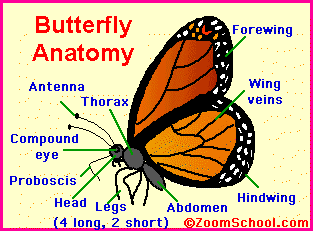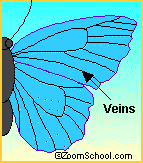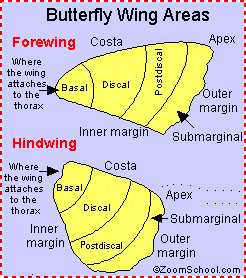|
|
 |
 |
Reply
 | |
 Butterflies are flying insects with two pairs of scaly wings and two segmented, clubbed antennae. Like all insects, they have a three-part body (head, thorax and abdomen), 3 pairs of jointed legs, compound eyes, and a segmented exoskeleton. Butterflies are flying insects with two pairs of scaly wings and two segmented, clubbed antennae. Like all insects, they have a three-part body (head, thorax and abdomen), 3 pairs of jointed legs, compound eyes, and a segmented exoskeleton.
Butterfly Physiology:
| FUNCTION | STRUCTURE IN BUTTERFLIES AND MOTHS | | Body structure and protection | An exoskeleton made of chitin, a type of protein | | Respiration (breathing) and Circulation of oxygen | Spiracles (9 pairs in butterflies) are pores open to the air and tracheae (air tubes) carry air through the body. Gas exchange occurs at the tiny ends of the tracheae. A very inefficient system which limits the size of butterflies. Spiracles are located on the abdomen and thorax. | | Circulation of oxygen | Tracheae | | Circulation of blood (for nourishment, not oxygen) | A long, tubular heart (dorsal vessel) and hemocoel | | Digestive System | Proboscis, pharynx, foregut (the crop), midgut, hindgut, and anus | | Storage of food energy | Fat body | | Excretion of wastes | Malpighian tubules, long filaments which clean the blood and put the waste (urine) into the hindgut (rectum) | | Nervous system | Brain, ventral nerve cord, ganglia, peripheral nervous system (PNS) and visceral nerves. | | Sense of balance (especially while flying) | Johnston's organ (located at the base of the antennae). | | Reproduction | Ovaries (female) and testes (male) | |
|
 First First
 Previous
2-5 of 5
Next Previous
2-5 of 5
Next Last
Last
|
 |
Reply
 | |
 The Head The Head  The butterfly's head is the location of its feeding and sensory structures. The almost spherical head contains its brain, two compound eyes, its proboscis, pharynx (the start of the digestive system), the point of attachment of its two antennae, Johnston's organ, mustache-like sensory palps, etc. The butterfly's head is the location of its feeding and sensory structures. The almost spherical head contains its brain, two compound eyes, its proboscis, pharynx (the start of the digestive system), the point of attachment of its two antennae, Johnston's organ, mustache-like sensory palps, etc.
Butterflies have no jaws; they sip liquid food through the proboscis, which uncoils for feeding. The proboscis is a a tube-like, flexible "tongue" that butterflies and moths use to sip their liquid food (usually flower nectar or the liquid from rotting fruits). The proboscis uncoils to sip food, and coils up again into a spiral when not in use. The lepidopteran with the longest proboscis is the hawk moth.
Compound eyes are made up of many hexagonal lens/corneas which focus light from each part of the insect's field of view onto a rhabdome (the equivalent of our retina). An optic nerve then carries this information to the insect's brain. Butterflies and moths see very differently from us; they can see ultraviolet rays (which are invisible to us).
Antennae (singular antenna) are sensory appendages attached to the head of butterflies and moths. Antennae are used for the sense of smell and balance. Butterflies have two segmented antennae with a small club at the end of each. Moths have antennae without the club. Johnston's organ is an organ located at the base of a butterfly's antennae. This organ are responsible for maintaining the butterfly's sense of balance and orientation, especially during flight.
Palps are the mustache-like scaly mouthparts of adult butterflies that are on each side of the proboscis. These palps are covered with sensory hairs and scales, and test whether something is food or not. |
|
Reply
 | |
 The Thorax The Thorax  The thorax is the locus for locomotion. The thorax is divided into three segments; on each segment is a pair of jointed legs. The four wings of the butterfly (or moth) are also attached to the thorax. The thorax contains the muscles that make the legs and wings move. The thorax is the locus for locomotion. The thorax is divided into three segments; on each segment is a pair of jointed legs. The four wings of the butterfly (or moth) are also attached to the thorax. The thorax contains the muscles that make the legs and wings move.
THE LEGS
Butterflies have six segmented legs. The two front legs of about half the butterfly species are very short. The front pair of legs are frequently used to clean the antennae. Each foot ends in a pair of grasping claws. The feet are also studded with sense organs and are used to taste food.
THE WINGS
The wings are attached to the second and third thoracic segments (the meso- and meta-thorax). During flight, the wings are held together because a lobe on the hindwing presses against the forewing. |
|
Reply
 | |
 Butterfly Wing Anatomy Butterfly Wing Anatomy   A butterfly has four wings, two forewings and two hindwings. They are attached to the second and third thoracic segments (the meso- and meta-thorax). Strong muscles in the thorax move the wings up and down in a figure-eight pattern during flight. A butterfly has four wings, two forewings and two hindwings. They are attached to the second and third thoracic segments (the meso- and meta-thorax). Strong muscles in the thorax move the wings up and down in a figure-eight pattern during flight. When the fully-grown adult butterfly emerges from its pupa, its delicate wings are crinkled, wet, and uninflated. The butterfly hangs upside-down and pumps blood into the wings to inflate them. It must then wait for the wings to dry before it can fly. When the fragile wings fray or are torn, they do not repair themselves.
 Wing Structure and Scales: Butterfly wings are made of two chitonous layers (membranes) that are nourished and supported by tubular veins. The veins also function in oxygen exchange ("breathing"). Covering the wings are thousands of colorful scales, together with many hairs (setae). The name Lepidoptera (which includes butterflies and moths) means "scale wing" in Greek. These wing scales are tiny overlapping pieces of chitin on a butterfly or moth wing. The scales are outgrowths of the body wall and are modified, plate-like setae (hairs). The front and back of the wings usually have different patterns. Wing Structure and Scales: Butterfly wings are made of two chitonous layers (membranes) that are nourished and supported by tubular veins. The veins also function in oxygen exchange ("breathing"). Covering the wings are thousands of colorful scales, together with many hairs (setae). The name Lepidoptera (which includes butterflies and moths) means "scale wing" in Greek. These wing scales are tiny overlapping pieces of chitin on a butterfly or moth wing. The scales are outgrowths of the body wall and are modified, plate-like setae (hairs). The front and back of the wings usually have different patterns. Scent scales are modified wing scales on the forewing of male butterflies and moths (on the costal fold) that release pheromones. These chemicals attract females of the same species. Scent scales are also called androconia. 
WINGSPAN
Wingspan is the distance measured across a butterfly's (or moth's) wings. The butterfly with the biggest wingspan is the Queen Alexandra's Birdwing, which has a wingspan up to 1 ft (30 cm) wide. | Color: Many butterflies and moths are brilliantly colored, while others are drab. There are often ultraviolet patterns in the wings that we cannot see, but which may be seen by other butterflies. Even many of the colorful species have drab-colored outer wings (that are visible when the animal is at rest). The coloration of these insects serves many purposes, including: - Camouflage, in which the color of the animal helps it blend into the environment, hiding the insect. The Australian leafwing butterfly, for example, is shaped and colored like a leaf.
- Warning (or aposematic) coloration: brightly-colored butterflies and moths are either bad-tasting or a mimic of similar-looking bad-tasting butterflies.
- Attracting and finding mates, who look for certain colors and patterns.
- Deceiving predators into thinking they're bigger than they really are. Some wings have large "eyespots" which make the butterfly or moth look like the face of a larger animal (like an owl), scaring away some predators.
- Soaking up heat: dark-colored scales soak up heat very well when the butterfly suns itself. Like all insects, butterflies are cold-blooded. When they get too cold, they warm themselves in the sun.
 Butterfly Wing Areas: A butterfly's wings are divided into the areas named in the illustration to the left. Butterfly Wing Areas: A butterfly's wings are divided into the areas named in the illustration to the left. The Coupling of the Wings: During flight, the forewing and hindwing are held together and function as one wing. The coupling mechanism differs in different species. In most butterflies, a lobe on the hindwing presses against the forewing. In most moths, bristles on the front edge of the hind wings (called the frenulum) connect with hooks on the hind edge of the forewing. In some moths, a lobe at the base of the forewings (called the jugum) overlaps the hindwings.  Wings At Rest: When at rest, butterflies hold their wings vertically. Moths hold their wings horizontally when at rest. A monarch butterfly at rest is pictured to the right. Wings At Rest: When at rest, butterflies hold their wings vertically. Moths hold their wings horizontally when at rest. A monarch butterfly at rest is pictured to the right.
|
|
Reply
 | |
 The Abdomen The Abdomen  The abdomen is relatively soft and is divided into 10 segments (7-8 are easily seen, the others are fused). The abdomen contains the butterfly or moth's simple, flexible, tube-like heart, Malpighian tubules, reproductive organs (claspers or ovipositors), many spiracles (breathing pores), and most of the digestive system (foregut, hindgut and rectum). The abdomen is relatively soft and is divided into 10 segments (7-8 are easily seen, the others are fused). The abdomen contains the butterfly or moth's simple, flexible, tube-like heart, Malpighian tubules, reproductive organs (claspers or ovipositors), many spiracles (breathing pores), and most of the digestive system (foregut, hindgut and rectum). |
|
 First First
 Previous
2-5 of 5
Next Previous
2-5 of 5
Next Last
Last
|
|
|
 Free Forum Hosting
Free Forum Hosting